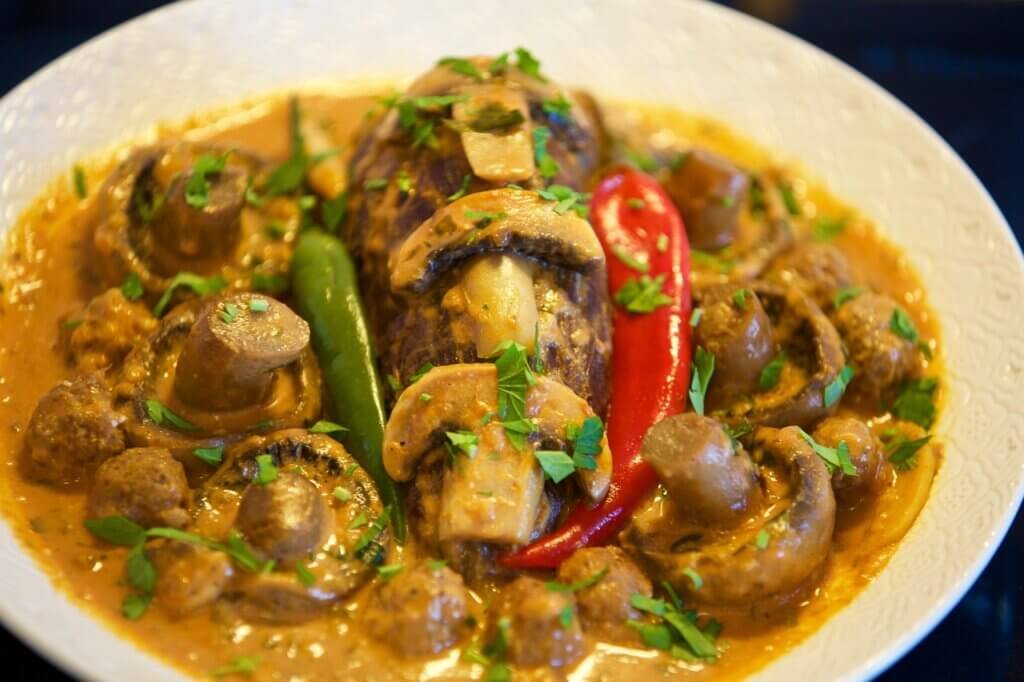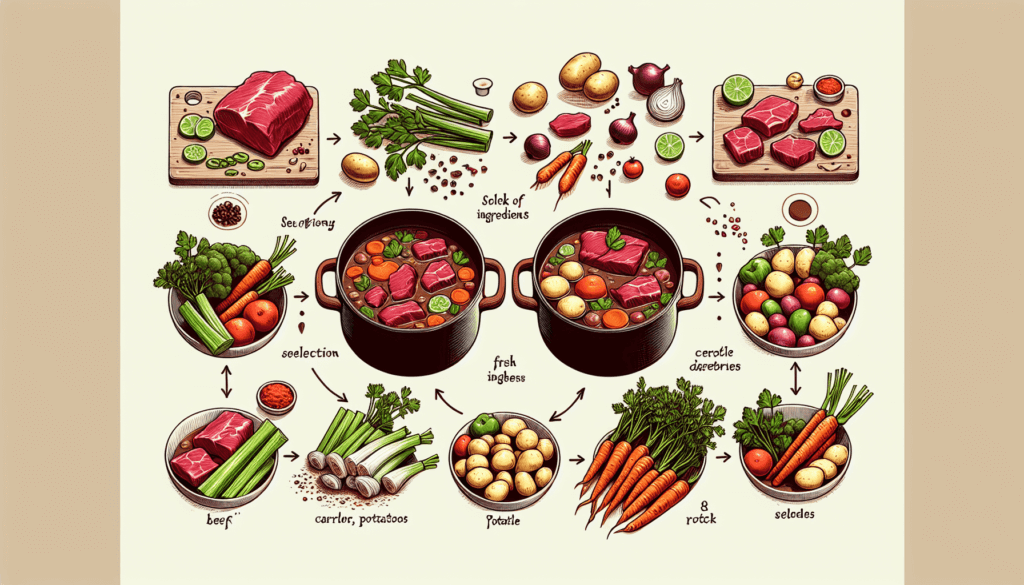Indulge in the tantalizing flavors of a hearty and comforting dish with our step-by-step guide to Traditional Beef Stew. This article will guide you through the process of creating a delectable stew filled with tender chunks of beef, rich aromatics, and an assortment of vegetables. From browning the meat to simmering it to perfection, our guide will ensure that every step is easy to follow, resulting in a satisfying meal that will warm your heart and soul. So grab your apron and let’s dive into the world of traditional beef stew!

Ingredients
Beef
One of the key elements of a traditional beef stew is, of course, the beef itself. You’ll want to choose a cut of beef that is suitable for slow cooking. Typically, cuts like chuck, round, or stew meat work best as they are well-marbled and have enough connective tissue to break down and become tender during the cooking process.
Vegetables
A hearty beef stew is incomplete without a medley of flavorful vegetables. Common choices include potatoes, carrots, onions, celery, and peas. These vegetables not only add depth of flavor but also provide a variety of textures that make each bite of stew a delightful experience.
Broth
To create a rich and flavorful base for your beef stew, a good-quality broth is essential. You have the option to use beef broth, vegetable broth, or even a combination of both. If you have the time and inclination, you can also make your own homemade broth using beef bones and aromatic vegetables.
Seasonings
The final touch to elevate the flavors of your traditional beef stew comes in the form of aromatic seasonings. Classic choices include bay leaves, thyme, rosemary, garlic, salt, and pepper. Feel free to experiment with different herbs and spices based on your personal preferences to create a stew that suits your taste.
Preparation
Choosing the Right Cut of Beef
When selecting the beef for your stew, it’s important to consider the cooking method. tougher cuts that require slow cooking, such as chuck or round, are ideal for beef stew. These cuts have more connective tissue, which breaks down during cooking and results in a tender and flavorful stew. Avoid lean cuts of meat as they may become dry and tough.
Preparing the Meat
Before adding the meat to your stew, it’s important to trim off any excess fat and cut it into bite-sized pieces. This ensures that the beef cooks evenly and is easy to eat. You can also choose to marinate the meat beforehand to enhance its flavor and tenderness. A simple marinade of Worcestershire sauce, soy sauce, and garlic works wonders.
Chopping the Vegetables
Preparing the vegetables is a crucial step in making a traditional beef stew. Peel and chop the potatoes, carrots, onions, and celery into roughly equal-sized pieces. This ensures that they cook evenly and maintain their texture throughout the cooking process. If using fresh peas, reserve them until the end to prevent overcooking.
Making the Broth
If you’re using store-bought broth, simply pour it into a measuring cup and set it aside. However, making your own broth can add an extra layer of flavor to your stew. To make homemade broth, simmer beef bones with aromatic vegetables like onions, celery, and carrots in a large pot for several hours. Strain the broth before using it in your stew.
Cooking
Searing the Meat
To achieve maximum flavor, it’s recommended to sear the meat before adding it to the stew. Heat a large pot or Dutch oven over medium-high heat and add a splash of oil. Once the oil is hot, add the beef in batches, being careful not to overcrowd the pot. Allow each piece of meat to develop a golden-brown crust before transferring it to a plate.
Adding the Vegetables and Broth
After searing the meat, it’s time to add the vegetables to the pot. Cook the onions, carrots, and celery for a few minutes until they start to soften. Then, return the seared meat to the pot and pour in the broth. The broth should just cover the ingredients. If necessary, add additional water or broth to ensure everything is submerged.
Simmering the Stew
Once all the ingredients are in the pot, it’s time to bring the stew to a simmer. Reduce the heat to low, cover the pot, and let it simmer for at least two hours or until the meat is tender and the flavors have melded together. Stir occasionally to prevent sticking and to ensure even cooking.
Adjusting the Seasonings
Taste the stew and adjust the seasonings to your liking. Add salt, pepper, or any additional herbs and spices to suit your taste buds. Remember, it’s always better to start with less seasoning and gradually add more, as you can’t take it out once it’s added.
Serving and Storage
Serving Suggestions
Traditional beef stew is a versatile dish that can be served in various ways. You can enjoy it on its own as a hearty and comforting meal, or pair it with some crusty bread or fluffy mashed potatoes for a more filling option. Some people also serve it over rice or noodles for a different twist. Garnish with fresh herbs, such as parsley or chives, to add a pop of color and freshness.
Storing Leftovers
If you have any leftovers, store them in an airtight container and refrigerate them promptly. Properly stored, beef stew can last for up to three to four days in the fridge. Alternatively, you can also freeze the stew for longer-term storage. To freeze, let it cool completely, portion it into freezer-safe containers, and store it in the freezer for up to three months.

Variations
Slow Cooker Beef Stew
For a convenient and hands-off approach to making beef stew, try using a slow cooker. Simply follow the same preparation steps, but instead of cooking it on the stovetop, transfer everything to a slow cooker. Cook on low heat for six to eight hours or on high heat for four to six hours until the meat is tender and the flavors are well-developed.
Instant Pot Beef Stew
If you’re looking for a quicker cooking method, an Instant Pot is your best friend. The Instant Pot allows you to achieve the same flavors and tenderness of a traditional beef stew in a fraction of the time. Follow the same preparation steps, then cook the stew in the Instant Pot on high pressure for 35-40 minutes. Allow for a natural release before serving.
Vegetarian Beef Stew
For those who prefer a plant-based option, a vegetarian beef stew can be just as delicious and satisfying. Replace the beef with hearty vegetables like mushrooms, root vegetables, or seitan. Use vegetable broth instead of beef broth, and adjust the cooking time accordingly to ensure all the vegetables are cooked through and tender.
Tips and Tricks
Choosing the Right Pot
When making beef stew, it’s essential to use a sturdy and heavy-bottomed pot or Dutch oven. This type of cookware ensures even heat distribution and prevents the stew from burning or sticking to the bottom.
Marinating the Meat
To further enhance the flavor and tenderness of the beef, consider marinating it for a few hours or overnight before cooking. A simple marinade of Worcestershire sauce, soy sauce, garlic, and herbs can do wonders.
Using Fresh Herbs
While dried herbs work well in a stew, using fresh herbs can take the flavors up a notch. Add fresh thyme, rosemary, or parsley during the simmering process to add a burst of freshness to the stew. Remember to remove any woody stems before serving.
Letting the Stew Rest
For the best flavor, allow the stew to rest for a few minutes after cooking. This allows the flavors to meld together and the meat to absorb the delicious broth. It also helps prevent the stew from being too hot when served.

FAQs
What can I serve with beef stew?
Beef stew pairs well with a variety of side dishes. Some popular options include crusty bread, mashed potatoes, rice, noodles, or even a simple green salad. Choose a side that complements the hearty flavors of the stew and adds an extra element to the meal.
How long does beef stew last in the fridge?
Properly stored in an airtight container, beef stew can last for three to four days in the refrigerator. Make sure to cool it before refrigerating and reheat it thoroughly before consuming.
Can I freeze beef stew?
Yes, beef stew can be frozen for longer-term storage. Allow the stew to cool completely before transferring it to freezer-safe containers or resealable bags. It can be stored in the freezer for up to three months. Thaw in the refrigerator overnight before reheating.
Conclusion
Making a traditional beef stew is a labor of love that results in a hearty and satisfying meal. From choosing the right cut of beef to simmering the stew to perfection, each step contributes to the rich flavors and tender meat that make this dish a classic. Whether you prefer the stovetop, slow cooker, or Instant Pot method, there are endless variations to suit your taste. So gather your ingredients, follow this step-by-step guide, and get ready to savor the comforting delight of homemade beef stew.



